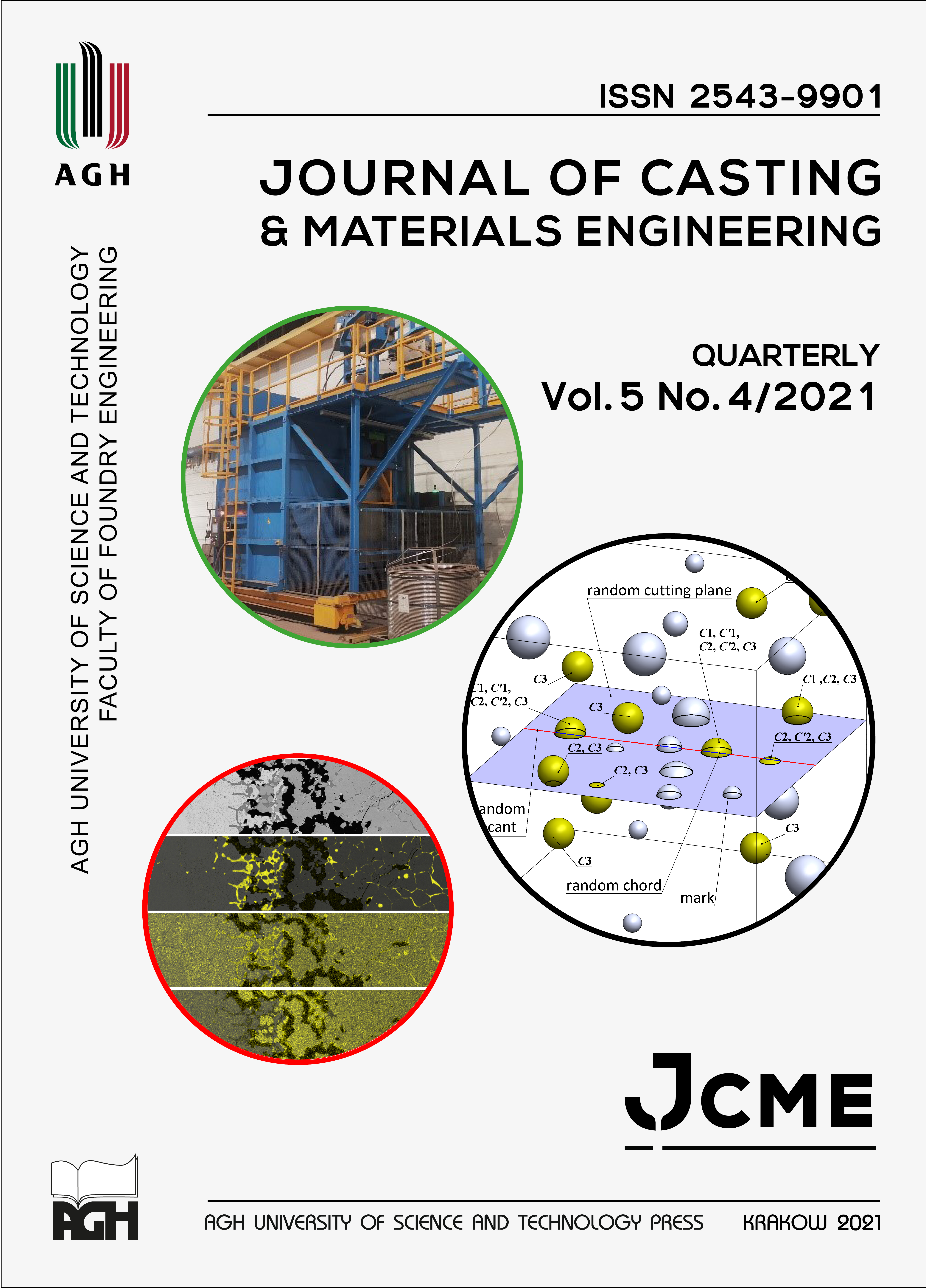Scaling Behaviour of Si-alloyed Steel Slabs under Reheating Conditions
DOI:
https://doi.org/10.7494/jcme.2021.5.4.71Abstract
Reheating of steel slabs for further processing such as hot rolling usually takes place in gas-fired pusher furnaces. Temperatures well above 1000°C, combined with an atmosphere containing H2O, CO2, and O2, lead to substantial oxidation of most steel grades. Newly developed advanced steels often contain significant amounts of Si. This element plays a dominant role in the scaling behaviour near the steel-scale-interface, since fayalite (Fe2SiO4) forms a eutectic with wuestite (Fe1–xO) that melts as low as 1177°C.
To better understand the high temperature oxidation behaviour, lab-scale trials were performed with different steel grades containing up to 3 wt.% Si. Possible interactions of Si with other alloying elements present in the samples such as Cr, Mn and Al were also of interest. The atmosphere contained 20% H2O, 7% CO2, and 3% O2, resembling reheating conditions in pusher furnaces, and temperatures ranged from 1100 to 1240°C. For metallographic investigation, the oxidised samples were cold mounted under vacuum using taper section angles. After preparation, the sections were examined through light microscopy, SEM/EDS, XRD, and TEM. The local distribution of the alloying elements could be mapped efficiently, and phase identification was successful in most parts. Under the applied experimental conditions, the elements of interest were present in their oxidic form either as pure or as mixed oxides. Higher Si-contents led to an increased build-up of eutectic melting phase at the steel-scale-interface at temperatures above 1177°C, which in turn further accelerated the oxidation.
Downloads
References
Fukagawa T., Okada H. & Maehara Y. (1994). Mechanism of Red Scale Defect Formation in Si-added Hot-rolled Steel Sheets. ISIJ International, 34(11), 906–911. Doi: https://doi.org/10.2355/isijinternational.34.906.
Hiratani T., Zaizen Y., Oda Y. & Senda K. (2018). Investigation of the magnetic properties of Si-gradient steel sheet by comparison with 6.5%Si steel sheet. AIP Advances 8, 056122. Doi: https://doi.org/10.1063/1.5007190.
Levin E.M., Robbins C.R. & McMurdie H.F. (1964). Phase Diagrams for Ceramists. Vol. 1. Columbus, Ohio: The American Ceramic Society.
Mouayd A.A., Koltsov A., Sutter E. & Tribollet B. (2014). Effect of silicon content in steel and oxidation temperature on scale growth and morphology. Materials Chemistry and Physics, 143(3), 996–1004. Doi: https:/doi.org/10.1016/j.matchemphys.2013.10.037.
Praig V.G., Haubner R. & Stöger-Pollach M. (2014). Microstructure and Composition of Grain Boundary- and Intragranular Oxides in Low Alloy Mn-Cr, Mn-Al-Si and Si-Al-P Hot-rolled Steel Sheets. Practical Metallography, 51(11), 785–799. Doi: https://doi.org/10.3139/147.110175.
Chen Y.R. (2020). Oversight or New Insight? Comments on Several Recent Papers Studying High-Temperature Oxidation of Si-Containing Steels. Oxidation of Metals, 93(1), 1–15. Doi: https://doi.org/10.1007/s11085-019-09947-5.
Höfler T., Danninger H. & Linder B. (2019). Examination of Oxide Scales Formed During Hot Rolling of Steels. Practical Metallography, 56(7), 449–456. Doi: https://doi.org/10.3139/147.110585.
Caplan D. (1960). Overtemperature in Metal Scaling. Journal of The Electrochemical Society, 107(4), 359–360.
Abuluwefa H., Guthrie R.I.L. & Ajersch F. (1996). The effect of oxygen concentration on the oxidation of low-carbon steel in the temperature range 1000 to 1250°C. Oxidation of Metals, 46(5), 423–440. Doi: https://doi.org/10.1007/BF01048639.
Dollase W.A., Seifert F. & O´Neill H.St.C. (1994). Structure of Cr2SiO4 and possible metal-metal interactions in crystal and melt. Physics and Chemistry of Minerals, 21, 104–109. Doi: https://doi.org/10.1007/BF00205221.
Birks N., Meier G.H. & Pettit F.S. (2006). Introduction to the High-Temperature Oxidation of Metals. 2nd ed. Cambridge: Cambridge University Press, 111–112.
Atkinson A. (1982). A theoretical analysis of the oxidation of Fe-Si alloys. Corrosion Science, 22(2), 87–102. Doi: https://doi.org/10.1016/0010-938X(82)90071-3.
Downloads
Published
Issue
Section
License
Copyright (c) 2021 Gregor Mikl, Thomas Höfler, Christian Gierl-Mayer, Herbert Danninger, Bernhard Linder, Gerhard Angeli

This work is licensed under a Creative Commons Attribution 4.0 International License.
How to Cite
Accepted 2021-10-20
Published 2021-11-02


